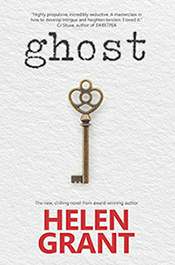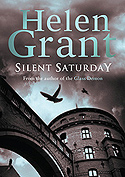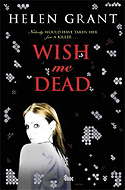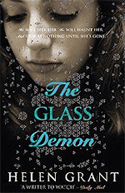As I mentioned in my last blog post, I was in London this week for an author visit to Chigwell School, and I managed to squeeze in a very quick visit to the Victoria and Albert Museum afterwards, to see the Steinfeld Abbey stained glass. I have seen it before, at the Schnütgen Museum in Cologne in 2007, where it formed part of a fabulous exhibition entitled Rheinische Glasmalerei: Meisterwerke der Renaissance (Rhenish Stained Glass: Masterpieces of the Renaissance). All the same, I couldn't resist taking the opportunity to see it again. I have a special affection for the Steinfeld glass; its history is so fascinating, and it has touched those who have been associated with it in an extraordinary way. The famous English ghost story writer M.R.James was inspired by it to write his chilling tale The Treasure of Abbot Thomas.
I've blogged about the glass before, for example in this post from May 2010: http://helengrantbooks.blogspot.co.uk/2010/05/glass-demon-published-today.html - its history was a major inspiration for my second novel, The Glass Demon.
I've also written several articles about it for the M.R.James Ghosts and Scholars Newsletter. You can see one of them here: http://www.users.globalnet.co.uk/~pardos/GSNews5.html#anchor60621 The other article, 'Lingering Memories of the Treasure': How the lost stained glass of Steinfeld was discovered, was published in issue 13 of the Newsletter (March 2008) and it has never appeared online. I intend to post it on my blog in the near future.
I wasn't sure until yesterday afternoon whether I would actually have time to visit the museum. The school visit was in Essex, a long journey to the eastern end of the Central Line. My train back to Edinburgh departed from King's Cross so the V&A down in South Kensington was definitely out of my way. However, I did manage to get there, although I only had about 45 minutes in the museum. It was years since my last visit (I've been abroad for most of the last decade, after all) and I was unable to work out where the glass was from the wall plans in the entrance hall, so I had to go and ask for help at the information desk.
"Is the Steinfeld glass on display?" I asked the young man on the desk.
He looked at me rather blankly. "How do you spell that?"
"S-t-e-i-n-f-e-l-d."
He looked at his computer. "Would that be in Mediaeval and Renaissance?"
"Yes," I said, and was instantly rather embarrassed at the sound of breathless excitement in my voice. Is there such a thing as a Stained Glass Geek? I think I have become one.
"Room 64, upstairs on the first floor."
I went upstairs but the layout was rather confusing; did he mean the first landing or the floor at the top of the stairs? Whilst I was debating this, a friendly security guard came out and asked me whether he could help. I explained that I was looking for room 64 because I wanted to see the Steinfeld stained glass. He very kindly directed me to it, adding, "If you go downstairs afterwards there is a room full of stained glass."
He was so friendly that I didn't like to say that it wasn't just any stained glass I was after, it was just one particular set of stained glass! Finally I found room 64 and there it was.
There were only a few windows on display. One or two others are in other rooms in the museum; most are in storage at the moment. As luck would have it, one of the windows on display is the one depicting the Fall of the Angels (in German, Engelsturz) which has a particular significance for me. In The Glass Demon, the heroine Lin describes a window from the fictional Allerheiligen Abbey, that depicts this same scene:
'I looked at the panel he was indicating; it was the one showing the Fall of the Angels. The upper part of the window was crowded with a throng of white-robed winged figures wielding swords and spears, descending out of skies the colour of Ceylon sapphires. Below them were the rebel angels, grotesquely ugly horned and winged creatures whose skin was tinted the crimson of blood or the green of decay. They tumbled down through empty space towards a bleak landscape of rock and fire far below, twisting and turning as they fell, jaws bared to reveal rows of jagged teeth snarling uselessly at their pursuers. Only one had his face turned outwards, as though staring out of the window directly at the observer. The expression on the red-tinted face was sly and complacent, even challenging, and painted with such detail that I could understand the rumours that Remsich had taken his figures from the life.'
The fictional window is based on the Steinfeld window of this subject, which you can see below, even down to the red demon with his calm complacent face staring out at the observer.
It is hard for me to express the extent of my fascination with the Steinfeld glass. Each time I have seen it, in 2007 and again yesterday, I have felt overwhelmed. Its history is so dramatic as to be almost improbable - lost for over a century, and rediscovered by someone who is himself famous for the ghost stories he wrote, in one of which the glass features.
More than that, since I became interested in the Steinfeld glass I have taken a general interest in stained glass of the period, and soon realised how little of it there is left, thanks to the church-wreckers of the Reformation. It really is a very rare treasure.
I'm also curious about the man who created much of it - Gerhard Remsich (sometimes rendered Remisch). In all my researches into the Steinfeld glass (much of it conducted amongst old German documents) I have never been able to discover anything about Gerhard Remsich the man and artist. All that we can know about him is painted into the glass: the dynamic compositions, the vivid colours, the meticulous brush strokes. Some faint echo of personality is evident in the energy and flair with which he depicted the ancient and well-worn Bible stories.
I took as many photographs as I could, and have posted some of them below. Photography was not permitted at the exhibition in the Schnütgen museum, so this is the first time I have had any photographs of my own to share, rather than posting links to other people's.
Finally I had to take my leave, hoping that this time it won't be another five years before I see the glass again. If there is CCTV in room 64, it may have caught sight of the lady in the leather jacket glancing around to make sure there was no-one else in the room, then blowing a kiss at the glass before hurrying away.
Subscribe to:
Post Comments (Atom)

















No comments:
Post a Comment